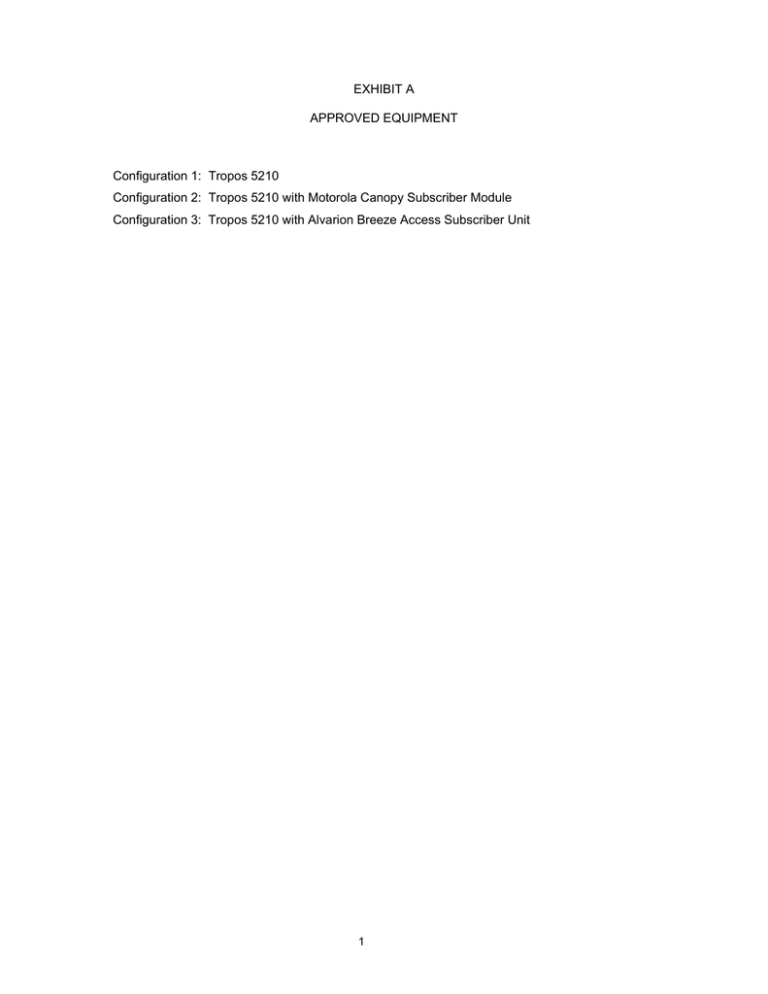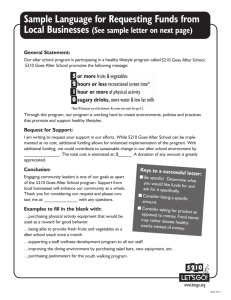EXHIBIT A APPROVED EQUIPMENT Configuration 1: Tropos 5210
advertisement

EXHIBIT A APPROVED EQUIPMENT Configuration 1: Tropos 5210 Configuration 2: Tropos 5210 with Motorola Canopy Subscriber Module Configuration 3: Tropos 5210 with Alvarion Breeze Access Subscriber Unit 1 Configuration 1: Tropos 5210 1. Description Tropos MetroMesh 5210 routers use a sophisticated mesh routing intelligence that is designed to optimize throughput in metro-wide Wi-Fi networks. Tropos routers create a self-organizing and self-healing wireless mesh that intelligently selects the optimum data path to the backhaul. The Tropos units can be mounted on external structures such as buildings or streetlights. Each MetroMesh router provides wireless connectivity to standard 802.11 b/g clients and extends the coverage area of the metro-scale Wi-Fi network. The ruggedized and weatherized Tropos 5210 is NRTL certified for outdoor installation. Each router covers an area with an approximate 600' radius, typically with an average 40 to 45 routers deployed per square mile. 2. Images 3. Power Consumption Actual consumption may vary by equipment, weather, or other non-controllable conditions; however, the table below shows the average power consumption of the Tropos 5210. Norm Volts 220V Amp Rating 0.08 Rating % 100% Operational Hours 731 KWh/Mo Billing 12.43 4. Attachment / Installation Process Each of the proposed Tropos 5210 units will be installed as appropriate on a street light, building or lamp post. The units are to be installed by a trade-qualified technician. The units can be mounted via standard brackets, which support lamp arm, post, building, and tower mounting. Installation of a unit typically takes 15 to 30 minutes, depending on the mount type. The brackets are designed to utilize a variety of standard mounting options, contain bubble-leveling meters and can be installed with a single size socket. Units are easily serviceable via a slide-off bracket and two screws. 2 The Tropos 5210 MetroMesh router can be mounted on the arm or the mast. Exploded view of the router and mounting assembly. 3 Proper Use of Hose Clamps - Large Poles (>= 8 Inches) Proper Use of Hose Clamps - Small Poles (< 8 Inches) 4 Street Light Mounting This image depicts the specifications and power tap configuration for the power input cable for the Tropos 5210 node. 5 5. Specifications Tropos 5210 Router Specifications Wireless • • • • IEEE 802.11b/g Frequency band: 2.4-2.483 GHz Modulation: 802.11g - OFDM (64-QAM, 16-QAM, QPSK, BPSK) 802.11b - DSSS (DBPSK, DQPSK, CCK) • TX Power: o Standard 14dBm-24dBm (EIRP) factory-set in 1dB units o High-Power 26dBm-36dBm (EIRP) factory-set in 1dB units • • • 7.4dBi Omni directional antennas Media Access Protocol: CSMA/CA with ACK Transmit and Receive diversity • RX Sensitivity: o o o o o o o o o o -100dBm @ 1 Mbps -94dBm @ 5.5 Mbps -92dBm @ 11 Mbps -95dBm @ 6 Mbps -93dBm @ 12 Mbps -90dBm @ 18 Mbps -87dBm @ 24 Mbps -84dBm @ 36 Mbps -79dBm @ 48 Mbps -77dBm @ 54 Mbps Networking • • • • • • • TCP and VPN session persistent roaming Full 802.11b/g client compatibility NAT support Layer 2 and Layer 3 support DHCP Server and Relay Sub-interface support Ethernet port Management • • • • • • • HTTPS to on-board configuration management tools Secure local and remote configuration via HTTPS SNMP V2c Tropos MIB Browser-based management tool Simple configuration save and restore Network & client monitoring and statistical capture features Security • • • • • • • • • WPA - (64, 128, 152-WEP with TKIP) Multiple ESSIDs Full VPN compatibility VPN filtering—rejects non-VPN traffic MAC address access control lists HTTPS only to on-board management tools AES encryption of wireless routing Packet filtering ESSID suppression Environmental Specifications • • • • • • • • Operating temperature range: -40°C to 55°C Storage temperature range: -40°C to 85°C Weather rating: IP67 weathertight Wind survivability: >165 mph Wind loading (165 mph): <1024 Newtons MIL-STD-810F 509.4 Salt Fog rust resistance compliant Shock & vibration: ETSI 300-19-2-4 spec T41.E class 4M3 Transportation: ISTA 2A 6 Optional Accessories • Street light NEMA photo-electric control power tap 90-480 V Package Contents • • • Tropos 5210 Mounting bracket and accessories Hardware Installation and Quick StartGuides Approvals • • • • • • • • • • • • • • FCC CFR 47 Part 15, Class B Industry Canada RSS 210 Taiwan DGT LP0001/LP0002 VCCI class B ARIB STD-T66 EN 301 489-17 EN 300 328 EN 60 950 IEC 950 UL 60950-1 CSA 22.2 No. 950 UL 579/IEC 60529 IP67 rated for outdoor use UL 1449/IEC 60 664-1 CE Hardware Specifications • • • • • • • • • • Autosensing 10/100BaseT Ethernet Power input: 90-480VAC 50/60Hz single and split-phase ANSI/IEEE C62.41 category C3 integrated branch circuit protection AC power consumption: 18 W typical Power over Ethernet power sourcing capability: 12Vdc @ 14W, 24Vdc @12W, 48Vdc @ 10W output Power-on and network status lamp: Green/Red Dimensions (w/o mounting brackets or antennas): 13.00 in (33.02 cm) wide x 8.00 in (20.32 cm) deep x 5.3 in (13.50 cm) high Weight: 14 lbs (6.40 kg) max., with mounting brackets • Antenna Protection: ≤ 0.5µJ for 6kV/3kA @ 8/20µS Waveform • Electrical Protection: o ANSI/IEEE C62.41, UL 1449-2nd ed., 10kA @ 8/20 μS Wave form, 36kA per phase, L-L, L-N, L-PE o EN61000-4-5 Level 4 AC Surge Immunity o EN61000-4-4 Level 4 Electrical Fast Transient Burst Immunity o EN61000-4-3 EMC Field Immunity • Data Protection: EN61000-4-2 Level 4 ESD Immunity • • One (1) year on parts and labor; return to point of purchase Optional standard and premium support packages available Protection Circuits Warranty 7 Configuration 2: Tropos 5210 with Motorola Canopy Subscriber Module 1. Description The Tropos 5210 with Motorola Canopy Subscriber Module mounting has a similar appearance to that of the Tropos 5210 mounting, with the addition of an attached Motorola Subscriber Module wireless antenna. The Motorola Subscriber Module antenna transmits data between itself and a Motorola Access Point antenna at the backhaul tower. The Motorola unit is mounted to a bracket which is attached directly to the Tropos 5210, and is also powered directly from the Tropos 5210 using power over Ethernet. 2. Images 3. Power Consumption Actual consumption may vary by equipment, weather, or other non-controllable conditions, however, the table below shows the average power consumption of the Tropos 5210 with a Motorola Canopy Subscriber Module. Norm Volts 220V Amp Rating 0.11 Rating % 100% Operational Hours 731 KWh/Mo Billing 17.91 4. Attachment / Installation Process To install the Canopy Subscriber Module, the mounting arm is oriented onto the desired side of the Tropos 5210 sun shield, and mounted with the three long screws into the corresponding holes. The Canopy SM is attached to the end of the Mounting Arm with appropriate clamps. The weight of the mounting arm is 8 ounces. The Canopy Subscriber Module is then connected via PoE to the Tropos 5210. 8 Assembly of the Tropos 5210 and Motorola Canopy Subscriber Module Configuration 9 Connecting Cat 5 Ethernet Cable from Canopy to Tropos Node 5. Specifications Motorola Canopy Advantage Subscriber Module Description Motorola Advantage SM (5.2 GHz, 5.7 GHz) Canopy Part Number 5200SM , 5750SM Market Availability North America, Latin America, Asia Signaling Rate 10 to 20 Mbps Maximum Typical LOS Range 2 Mile (3.2 km) max Typical Aggregate Useful Throughput 14 Mbps to 1 Mi Frequency range of band U-NII 5250-5350 MHz, ISM 5725-5850 MHz Non-overlapping Channels 3 (5.2 GHz) or 6 (5.7 GHz) Channel Width 20 MHz Channel Spacing every 5 MHz Modulation Type High Index 2-level Frequency Shift Keying (FSK) optimized for interference rejection Encryption DES capable Latency 5 - 7 msec Carrier to Interference ratio (C/I) ~3dB @ 10 Mbps, ~10dB @ 20 Mbps at -65dBm Nominal Receiver Sensitivity (dbm typical) -86 dB Antenna Gain (dB) 7 dB EIRP (dB) 30 dB Equivalent Isotropic Radiated Power (EIRP) 1W DC Power (typical) 0.3 A @ 24 VDC = 7.2 W 10 Antenna Beam Width 3 dB antenna beam width 60 degrees, Azimuth and Elevation Temperature -40° C to +55° C (-40° F to +131° F) Wind Survival 190 km/hr (118 miles/hr) Dimensions 11.75 in H x 3.4 in W x 3.4 in D (29.9 cm H x 8.6 cm W x 8.6 cm D) Weight .45 kg (1 lb) Access Method Time Division Duplexing/Time Division Multiple Access (TDD/TDMA) Interface 10/100 Base T, half/full duplex. Rate auto negotiated (802.3 compliant) Protocols Used IPV4, UDP, TCP, ICMP, Telnet, HTTP, FTP, SNMP Network Management HTTP, TELNET, FTP, SNMP Version 2c FCC ID ABZ89FC3789, ABZ89FC5804 Industry Canada Certification Number 109W-5200, 109W-5700 NYCE 0202CE08128, 0202CE08128 11 Configuration 3: Tropos 5210 with Alvarion Breeze Access Subscriber Unit 1. Description The Tropos 5210 with Alvarion Breeze Access Subscriber Unit mounting utilizes a typical Tropos 5210 mounting, with the addition of an attached Alvarion Breeze Access Subscriber Unit. The Alvarion Breeze Access Subscriber Unit transmits data between itself and an Alvarion Access Point antenna at the backhaul tower. The Alvarion unit is mounted to a separate bracket which may be mounted on the mast, at a minimum distance of 1 foot from the arm/pole connection point. 2. Images The Alvarion is mounted on the pole, not the arm. It is powered by the Tropos via an Ethernet cable. 3. Power Consumption Actual consumption may vary by equipment, weather, or other non-controllable conditions, however, the table below shows the average power consumption of the Tropos 5210 with an Alvarion Breeze Access Subscriber Unit. Norm Volts 220V Amp Rating 0.11 Rating % 100% Operational Hours 731 4. Specifications Specification Frequency Description • • • Radio Access Method Channel • Central Frequency Resolution • • • • 5.725 – 5.850GHz, 5.47 – 5.725GHz, 5.15 – 5.35GHz Time Division Duplex (TDD) 10 MHz, 20 MHz 5 MHz, 10MHz 12 KWh/Mo Billing 17.91 Output Power (at antenna port) Sensitivity, typical (dBm at antenna port) Modulation Scheme Antenna Port (AU-RE) Subscriber Integrated Antenna Specification Local & Remote Management Remote Management Access Management Access Protection Software upgrade SNMP Agents Type SU-NI, AU-NI Ethernet Radio AC IN Type EMC Safety Environmental Lightning protection Radio MIL-STD-810F 509.4 • SU: -10 dBm to 21 dBm, automatically adjusted to ATPC Modulation 1 2 3 4 5 6 7 Level*(20 MHz) -89 -88 -86 -84 -81 -77 -73 Level* (10 MHz) -92 -91 -89 -87 -84 -80 -76 * Modulation Level combines modulation scheme and cooling gain. OFDM: BPSK, QPSK, QAM 16, QAM 64 N-Type 50 ohm 21 dBi, 10.5˚ H/V, Integrated flat panel 8 -71 -74 Description Monitor via Telnet, SNMP and Configuration Upload/Download From Wired LAN, Wireless Link Multilevel Password Configuration of remote direction (From Ethernet only, Wireless only, or both sides) • Configuration of IP addresses of authorized stations Via TFTP and FTP SNMP v1 client, MIB II, Bridge MIB, Private BreezeACCESS VL MIB • • Connectors 10/100BaseT RJ-45, 2 embedded LEDs 10/100BaseT Ethernet RJ-45 3-pin AC power plug • • Electrical AC input: 100-240VAC, 50/60Hz via PoE from Tropos Power consumption: 8W Standard FCC Part 15 Class B, CE ETSI EN 301 489-1/4 UL 60950-1, EN 60950-1 Operation • ETS 300 019 part 2-3 class 3.2E for indoor units • ETS 300 019 part 2-4 class 4.1E for outdoor units Storage ETS 300 019-2-1 class 1.2 E Transportation ETS 300 019-2-2 class 2.3 EN 61000-4-5, class 3 (2kV) FCC Part 15 EN 301 752 EN 301 021 EN 301 893 (V 1.3.1) Salt Fog rust resistance compliant • • • Specification Alvarion SU Wind loading: 12" x 12" antenna Weight Light Arm Mount Weight with 24.5" 1.75 OD thin wall galvanized mast Preliminary Wind Survivability Wind Loading @165 mph Dimensions 13 Description 31.82 lbs of force @ 100 mph 2.3 kg or 5.04 lbs. with the antenna 4lbs. 13oz. 165 mph <300 Newtons or <67.44 lbs force 8" x 4.625" x 3" Rotation 45 deg. From vertical or horizontal axis This Page Left Blank Intentionally 14
